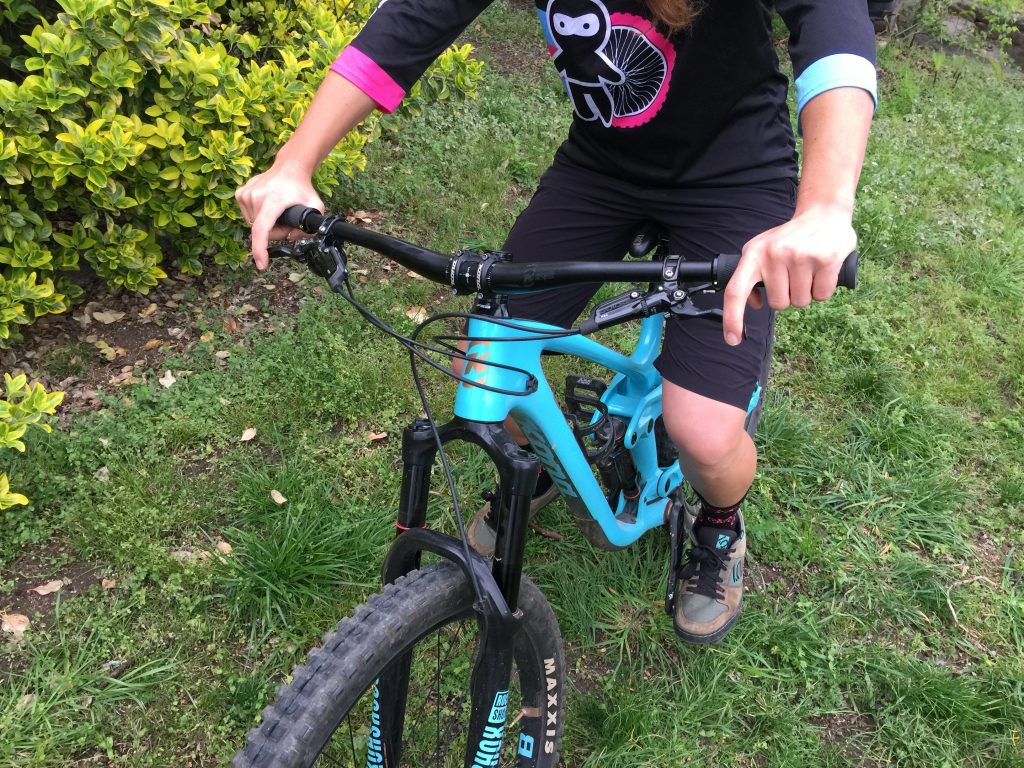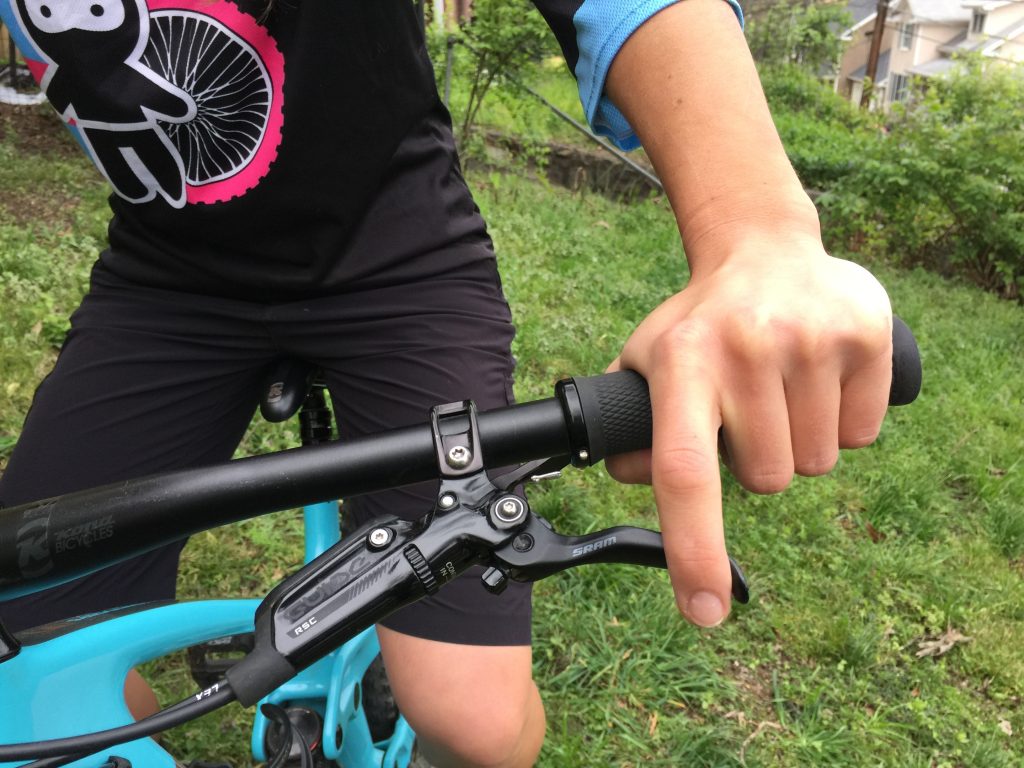When not to use your middle finger
Is your braking holding you back?
Much of an experienced mountain biker’s control, skill and speed lies both in the way they use their brakes (ease the squeeze!) AND the way they set-up their brake controls on the bars. In this article, we’re going to focus on the importance of proper set-up of your brake levers. Correct brake lever positioning is a critical component to maintaining positive control of your bike.
 Modern mountain bikes with hydraulic disc brakes have brake levers that are specially designed to be used by one finger, your index finger, in ALL situations. With your hands positioned correctly on the handle bars, the last joint in your index finger (distal interphalangeal) should line up perfectly with the bend at the end of your brake levers. When checking for this alignment, make sure your hands are completely on the hand grips — if the side of your hand is hanging off the bars (grips) you’ll be putting pressure on your Ulnar nerve. This pressure can cause numbness in your hand and arm, fatigue, discomfort and diminished control of your bike.
Modern mountain bikes with hydraulic disc brakes have brake levers that are specially designed to be used by one finger, your index finger, in ALL situations. With your hands positioned correctly on the handle bars, the last joint in your index finger (distal interphalangeal) should line up perfectly with the bend at the end of your brake levers. When checking for this alignment, make sure your hands are completely on the hand grips — if the side of your hand is hanging off the bars (grips) you’ll be putting pressure on your Ulnar nerve. This pressure can cause numbness in your hand and arm, fatigue, discomfort and diminished control of your bike.
 Adjusting the positioning of your brake levers so that your index finger naturally lines up with this bend in the brake lever, will give you better bike control, a better feel for what the brakes and tires are doing and greater confidence in your riding.
Adjusting the positioning of your brake levers so that your index finger naturally lines up with this bend in the brake lever, will give you better bike control, a better feel for what the brakes and tires are doing and greater confidence in your riding.
Let’s talk about the “why”.
With one finger braking, three fingers from each hand are sharing the job of holding the bar– even during gear shifting and using your dropper post. Your hands are more secure and balanced on the bar. Any less than three fingers on the bar and your ability to control the bike will diminish. Correct lever positioning leads to reduced hand and arm tension, an overall reduction in stiffness and improved flow and easier shifting. This secure control of the bar will allow you to push your limits, use the brakes less and keep momentum while riding.
Not convinced? Still want to brake with your middle finger or your middle finger and index finger? Let’s do a quick experiment to explore the science behind all of this from science made simple.
Try this…
Bend your middle finger and place the center section on a table or hard surface. You will be able to lift your thumb, index, and little finger without moving your middle finger. But it is impossible to lift your ring finger.
What is happening?
The tendons in your fingers are independent from one another apart from the ones in your middle and ring finger. These tendons are connected, so that when your middle finger is folded down you cannot move your ring finger. It feels like your ring finger is stuck!
Now, let’s bring this back to the bike. If you use your middle finger to brake, your ring finger strength is compromised because it can’t independently hold onto the bars. For optimal braking and control, let your free bending index finger do all the braking while the rest of the hand focuses on control, shifting and operating your dropper post.
Take the leap and switch to one finger braking. That nervous feeling of not having enough steering control at high speed will be a thing of the past.







Can you do this if you don’t have disc brakes? Does it work with the cantelever brakes?
Hi Eli! Thanks for your question. It most cases, yes — you should use one finger (your index finger) for braking regardless of your braking system. However, I can see where (with cantilever brakes) you might find situations (steep / fast descents) where one finger isn’t enough — and unfortunately, you’re going to have to sacrifice some handling / grip control and add another finger to your brake levers. Keeping your brake pads clean and properly aligned can go a long way for maintaining the best possible braking power.
Sorry, but I totally disagree with you guys about index finger braking. Using your middle finger gives you a wider grip on the bars and thus, more control, and allows you to shift with the index finger while braking if needed. That tendon thing you describe has nothing to do with this. With the middle finger on the brake lever the ring finger still has full grip power. Try this: Put you middle finger out and see if you can still grip the bar with your ring finger, yes, you can!
After braking with just my middle finger for 6 years now, I read through this article thinking that there was no way it would change me. Then I did the little ‘middle finger on the table experiment’ and instantly thought: “that’s it…I am going to change my riding style tomorrow”…then I read this comment and thought: “yeah…wait, he’s right: I CAN grip my bar with my other 3 fingers just fine”
So…thank you Mark…You restored my faith in my own goofy riding style!
Cheers mate!
First off, I just re-read this article and agree with you and Mark … to an extent. I think we got too caught up in the catchy title.
In hindsight, this article would have been better written as “When Not to Brake with Two Fingers”. Referring to your middle finger AND your index finger [which we commonly see in riders attending our events].
As you’ve both indicated, you still get a pretty good grip with your index, ring and pinky finger on the bars, BUT still not as strong as the grip (and control) you get from your middle, ring and pinky.
Additionally, there’s one other factor you’re both overlooking …
When you brake with your middle finger, your index finger is in the way of your brake lever. In order to engage your brake with your index finger on the grip, you have to set your brake levers engagement point way out in front of your handgrips.
Most Professional Enduro/DH riders ride with their brake levers very close to the bars, often barley touching or less than 1mm off the bars when fully actuated. This give them lots of grip / control and keep the brake levers quickly accessible.
I appreciate your feedback / comments and would love to keep the discussion going.
Thanks for the response and validation! I totally agree that with modern disc brakes 2 finger braking is not needed or desired.
I don’t know if I’d get a stronger grip when braking with my index finger, but I do know that I grip over a wider area when braking with my middle finger, which gives better control.
That’s an interesting point about the index finger being in the way when braking with the middle finger. I’ve never actually changed the engagement point on any of my brakes and it’s not an issue. If my brake lever is getting that close to the bars, something is wrong and needs to be addressed, like a brake bleed or new pads. I have no idea about DH or Enduro racers, but normal riders do not set their brakes up with levers that close to the bars.
I guess I’m a bit of an outlier, as most people brake with their index finger…
I had on-going issues with “tennis elbow” that seemed to be related to my riding. When I switched to single finger braking using my index fingers, the elbow pain went away and has never returned.
Perhaps Emily Batty needs the input of your wealth of experience.
What’s the solution if you have a longer brake lever but a smaller hand? When I move the brake further away from my hand so that I can use just one finger, the shifters are too far away. And due to the way the shifters are made (with a gear display), I can’t move them inside of where the brake attaches to the handlebar.